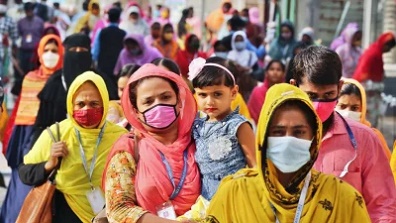-CEIC data says (Labor Force Participation Rate) of country was 58.79 pc in 2021. By end of 2023, it reduced to 58.16 pc
-At 2023, women were 32 lakh 20K more than men. Currently, this gap is close to 40 lakhs.
According to Bangladesh Bureau of Statistics (BBS), the total population of the country in 2023 was a little over 17.29 million. According to the United Nations, it currently stands at 17.47 million. In the past, the population growth rate in Bangladesh was seen to slow down, but the situation has changed since the Covid-19 pandemic. Since that time, the population growth rate in Bangladesh has become upward again. According to a review of the statistics of the Population Division under the United Nations Department of Economic and Social Affairs, the country's population growth rate was downward until 2021. But since then it has started to grow again. The growth rate was 85 percent in 2019, which declined to 82 percent by 2021. But the next year it increased to 1.03 percent. In 2023, it increased to 1.23 percent. Its estimated rate in 2024 is 1.22 percent. And according to BBS data, the average annual population growth rate in Bangladesh between the two censuses from 2011 to 2022 was 1.12 percent. Accordingly, the annual growth rate currently exceeds the average rate for the period between the two censuses. In the country, the rate of increase in the number of women is relatively higher than that of men. At the end of 2023, the number of women in the country was 32 lakh 20 thousand more than men. Currently, this gap is estimated to be close to 40 lakhs. Dr. Fahmida Khatun, executive director of economist and think tank organization Center for Policy Dialogue (CPD), said, "The rate of 26-year-old youth is the highest in our country's population. Although the number of young people is increasing, they are not being given employment. As a result they are unable to do anything by working for themselves. Again, they are not getting the opportunity to contribute to the country's economy. But after 2035 to 40 there will be no more youth dependent Bangladesh. The working population cannot then be exploited as such. Therefore, to benefit from demographic benefits or demographic dividend, it is now necessary to engage the youth with training and financial assistance.
The labor market participation rate of the working population in the country is now low. According to the global economic database CEIC data, the labor force participation rate (Labor Force Participation Rate) of the working population in the country was 58.79 percent in 2021. By the end of 2023, it has come down to 58.16 percent. Economists fear that Bangladesh will not be able to achieve demographic dividends if the participation of young people in the labor market is not increased. Dhaka University Vice-Chancellor (Administration) and Professor of Economics Dr Saima Haque Bidisha feels that investment and many policy changes are necessary to utilize the youth-based manpower. He said, 'We are in a demographic advantage. If I want to make it a dividend then it's not just the age structure that's there for my convenience. Besides that demographic, that young energy; They also need to be educated, skilled and functional. But we have had a lot of discussions about the demographic dividend. We have not been able to properly utilize the youth unemployment rate, labor force participation, education and training that we need to be in an advantageous position. Now there is a need for job creation to harness this youth power in the policy field. This needs to be worked on. The youth, who are in rural areas, the youth who are in urban centers should work to increase their job opportunities and skills. More recruitment is needed in these places. Allocation for education and health in our current budget is very inadequate. Allocation to Ministry of Youth and Labor is very less. Big changes are needed in those areas. That is why we need new directions and policies. There is a need to redo the government's policy and allocation targeting education and employment.
In the country, the rate of increase in the number of women is relatively higher than that of men. At the end of 2023, the number of women in the country was 8 crore 80 lakh 70 thousand. And the number of men was 8 crore 48 lakh 50 thousand. Accordingly, at the end of 2023, the number of women in the country was 32 lakh 20 thousand more than men. Although there is no information about the number of men and women at present, experts believe that the gap has increased by reviewing various mathematical models. It is estimated that this gap is close to 40 lakhs.
Bangladeshi men and women are showing equal skill and talent in the workplace. However, the existing challenges of women's participation in the economy in Bangladesh have not been overcome yet. In addition to eliminating various mental and environmental barriers, there has not been much progress in ensuring a safe working environment. Experts fear that if these obstacles are not removed, it will be more difficult for Bangladesh to use the country's female-dominated workforce in the coming days.
Experts feel that it will be more difficult for Bangladesh to achieve demographic dividend if the challenges of women's participation in the economy are not removed in the coming days. Mohammad Billal Hossain, Professor of Population Sciences Department of Dhaka University, said, "The overall condition of the labor market, there is less formal place for educated workers. As a result, the lack of gender advantage among graduates, especially tertiary educated graduates, is one of the reasons for the backwardness of women in the labor market. Society is not yet ready to see women in such a role. Women are overrepresented in medicine, but their participation in engineering is very low. Family and society want to send women to certain professions. Society is not yet ready to consider women suitable for all professions. Again, many women cannot come to the labor market, because they do not get the institutional benefits that are supposed to be given to them there. For example, day care services for children in institutions are not yet developed. As much as the service has been created, that too is only for the duration of the office. If the psychological changes are not ensured, it will appear alarming for the society and the economy. However, many changes are happening in Bangladesh now. Today, there is a lot of difference between the mindset of 20 years ago. It's too slow though.'
Regarding government statistics being questioned, he said, "We have created a place of distrust in all areas. We have not yet realized the role and importance of data in policy-making in that sense. If we don't have the right statistics, how can we make the right decision? Our investment in data collection is also not done properly. This matter is also important.
ZH






